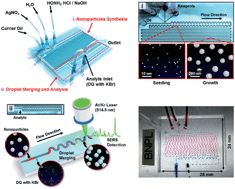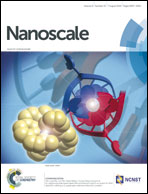Real-time analysis of diaquat dibromide monohydrate in water with a SERS-based integrated microdroplet sensor†
Abstract
We report the fast and sensitive trace analysis of diaquat dibromide monohydrate (DQ) in water using a surface-enhanced Raman scattering (SERS)-based microdroplet sensor. This sensor is composed of two compartments: the first one is for droplet generation for fresh silver nanoparticle (AgNP) synthesis and the second for droplet merging for SERS detection. Silver ions were nucleated and grown to large size AgNPs in droplets, and then each droplet was synchronously merged with another droplet containing DQ for SERS detection. This two-phase liquid–liquid segmented flow system prevented memory effects caused by the precipitation of nanoparticle aggregates on channel walls because the aqueous droplets were isolated by a continuous oil phase. The limit of detection (LOD) of DQ in water was determined to be below 5 nM, which satisfies the maximum contaminant level defined by the United States EPA. This method was also validated successfully in DQ-spiked tap water. The SERS-based integrated sensing system is expected to be useful as an in-the-field sensing platform for fast and reproducible trace analysis of environmental pollutants in water.


 Please wait while we load your content...
Please wait while we load your content...